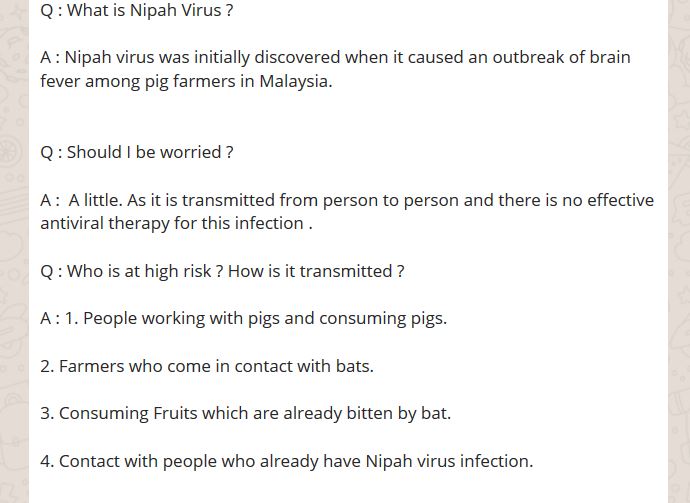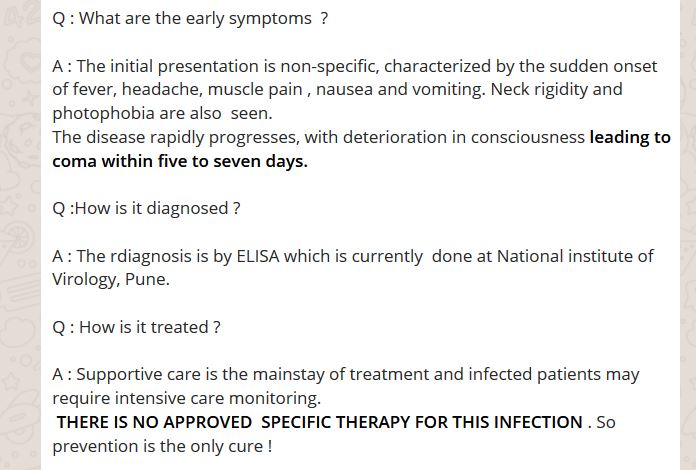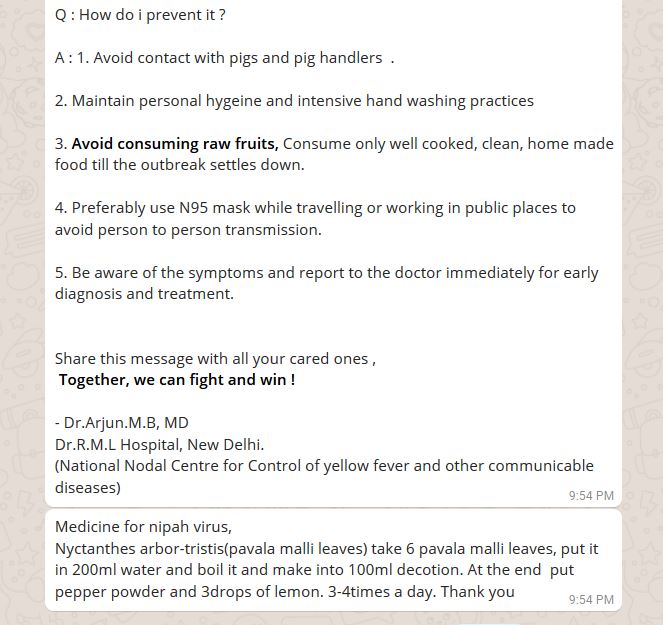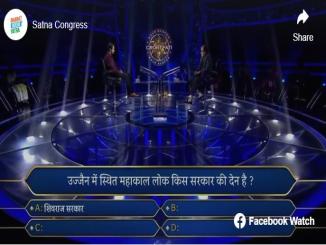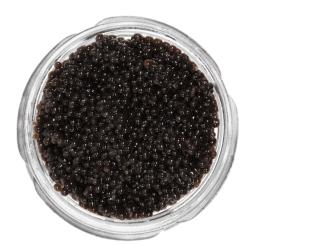
Brief Outline: The viral message describing Nipah virus and cure process as Nyctanthes arbor-tristis (pavala malli leaves) take 6 pavala malli leaves, put it in 200ml water and boil it and make into 100ml decotion is fake.
Ayupp Verification: Mostly Fake
Origin: The news is widely popular on the social media sites.
Viral Example: Q : What is Nipah Virus ?
A : Nipah virus was initially discovered when it caused an outbreak of brain fever among pig farmers in Malaysia.
True
Q : Should I be worried ?
A : A little. As it is transmitted from person to person and there is no effective antiviral therapy for this infection .
False
Q : Who is at high risk ? How is it transmitted?
A : 1. People working with pigs and consuming pigs.
- Farmers who come in contact with bats.
- Consuming Fruits which are already bitten by bat.
- Contact with people who already have Nipah virus infection.
True
Q : What are the early symptoms ?
A : The initial presentation is non-specific, characterized by the sudden onset of fever, headache, muscle pain , nausea and vomiting. Neck rigidity and photophobia are also seen.
The disease rapidly progresses, with deterioration in consciousness leading to coma within five to seven days.
Q :How is it diagnosed ?
A : The rdiagnosis is by ELISA which is currently done at National institute of Virology, Pune.
False
Q : How is it treated ?
A : Supportive care is the mainstay of treatment and infected patients may require intensive care monitoring.
THERE IS NO APPROVED SPECIFIC THERAPY FOR THIS INFECTION . So prevention is the only cure !
False
Q : How do i prevent it ?
A : 1. Avoid contact with pigs and pig handlers .
- Maintain personal hygeine and intensive hand washing practices
- Avoid consuming raw fruits, Consume only well cooked, clean, home made food till the outbreak settles down.
- Preferably use N95 mask while travelling or working in public places to avoid person to person transmission.
- Be aware of the symptoms and report to the doctor immediately for early diagnosis and treatment.
Share this message with all your cared ones ,
Together, we can fight and win !
- Dr.Arjun.M.B, MD
Dr.R.M.L Hospital, New Delhi.
(National Nodal Centre for Control of yellow fever and other communicable diseases)
Nyctanthes arbor-tristis(pavala malli leaves) take 6 pavala malli leaves, put it in 200ml water and boil it and make into 100ml decotion. At the end put pepper powder and 3drops of lemon. 3-4times a day. Thank you
Detailed Analysis: If you believe in the WhatsApp promoted message you don’t need to go to a hospital for the cure of Nipah virus. A message has been floating on the social media attributed to Dr.R.M.L Hospital, New Delhi and doctor Arjun.M.B, MD.
The virus has currently lead to quite a number of death’s in Kerala. At present 11 people have died due to this virus and people are curious to know all about the virus.
The hospital has not given any written clarification that this message is being circulated on their behalf.
Let’s have a cross fact check on the viral message.
Q : What is Nipah Virus ?
As per WHO Nipah virus (NiV) infection is a newly emerging zoonosis that causes severe disease in both animals and humans. The natural host of the virus are fruit bats of the Pteropodidae Family, Pteropus genus.
NiV was first identified during an outbreak of disease that took place in Kampung Sungai Nipah, Malaysia in 1998. On this occasion, pigs were the intermediate hosts. However, in subsequent NiV outbreaks, there were no intermediate hosts. In Bangladesh in 2004, humans became infected with NiV as a result of consuming date palm sap that had been contaminated by infected fruit bats. Human-to-human transmission has also been documented, including in a hospital setting in India.
NiV infection in humans has a range of clinical presentations, from asymptomatic infection to acute respiratory syndrome and fatal encephalitis. NiV is also capable of causing disease in pigs and other domestic animals. There is no vaccine for either humans or animals. The primary treatment for human cases is intensive supportive care.
First outbreak of Nipah virus in Malaysia and Singapore
Nipah virus infection was first recognized in a large outbreak of 265 suspected cases in peninsular Malaysia during September 1998 to April 1999. Most patients had contact with sick pigs or had been in close physical contact with Nipah virus infected patients and then presented primarily with encephalitis. The outbreak was initially thought to be due to Japanese encephalitis, but it was later identified as Nipah virus encephalitis. This outbreak caused widespread panic and fear in Malaysia leading to considerable social disruptions and tremendous economic loss because of the mass culling of over one million pigs. In addition, eleven abattoir workers in Singapore developed a febrile illness caused by Nipah virus during March 1999 following close contact with imported pigs from Malaysia. The presentation of Nipah virus infection has been variable, ranging from the high mortality observed in the original Malaysian outbreak to an outbreak of low mortality disease among abattoir workers in Singapore, which presented as neurological illness and atypical pneumonia. No new outbreaks have been reported from these countries since May 1999.
Q :How is it diagnosed ? Q : How is it treated ?
THERE IS NO APPROVED SPECIFIC THERAPY FOR THIS INFECTION. Doctors are more focused on managing the fever and neurological symptoms the So prevention is the only cure !
null
null
Nipah virus infection
Nipah virus (NiV) infection is a newly emerging zoonosis that causes severe disease in both animals and humans. The natural host of the virus are fruit bats of the Pteropodidae Family, Pteropus genus. NiV was first identified during an outbreak of disease that took place in Kampung Sungai Nipah, Malaysia in 1998.
Nipah virus outbreaks in the WHO South-East Asia Region
Nipah virus (NiV) encephalitis is an emerging infectious disease of public health importance in the WHO South-East Asia Region. Bangladesh and India have reported human cases of Nipah virus encephalitis. Indonesia, Thailand and Timor-Leste have identified antibodies against NiV in the bat population and the source of the virus has been isolated.

